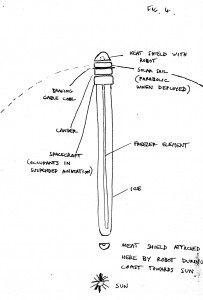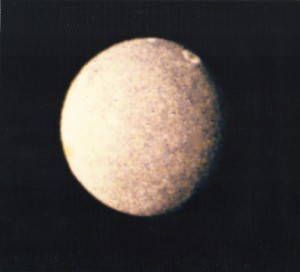12 November 2017
![]() Below is the first part of the unpublished ICE NEEDLE Hawke/McLane story . After the description of how the launch system might work in last week’s post Duncan now takes up the story itself :-
Below is the first part of the unpublished ICE NEEDLE Hawke/McLane story . After the description of how the launch system might work in last week’s post Duncan now takes up the story itself :-
“For the purposes of the story, this project was the brainchild of a group of Japanese scientists who were determined Japan should be first to one of the planets. Uranus was the next target, before the disaster, and they were prepared to make it a one-way trip because they believed there was a major discovery to be made among the moons (see below). At the time of the C-Day [ collision day - the day in the Hawke/McLane universe when part of the Moon hit the Earth - my note –Skipper Prossitt] , they were ready to launch and had already gone into suspended animation in the ship – partly to withstand the very high launch acceleration but also because the ship itself is too small to carry supplies for the trip, in towards the Sun and then out again. Since the disaster the sea level has been too low to reach the intakes, because so much water has been locked up in the temporary ice-caps; but now that the ice is receding the sea-level is rising, and it reaches the intakes and triggers the automatic systems. So the occupants are on their way, not knowing how much things have changed in the meantime: they’re lucky to get away from the Earth without hitting the ring of debris – room here for a spectacular drawing of a near miss.

Of course the launch is seen, and records of the project are uncovered, though Japan itself is only now emerging from the ice. The Faith, which is still attached to the Mercury project, is scrambled to try to intercept the Needle before it goes into the next propulsion phase, but doesn’t quite make
the rendezvous in time. The shield is blown off, the tip of the Needle is exposed to full sunlight as it swings through its closest approach to the Sun, and the Needle accelerates outward – too high an acceleration for the Faith to match. (We worked out before that one-tenth of a g is top acceleration for the starships.) Another attempt to intercept is made from Earth as the Needle is heading away from the Sun and its acceleration begins to drop; but then the ship deploys its parabolic solar sail (fig. 4) to focus sunlight from a large collecting area on to the tip of the Needle. Because the mass
of the Needle is going down all the time, this means that it will be able to keep up a high acceleration at least until well out past the asteroid belt, giving it a very high transfer velocity to Uranus. The only chance now for the occupants, who are still in suspended animation, is for the Hope to meet them at Uranus on its way back from the 10th planet.
Notice that the Needle is getting shorter all the time, so the parabolic sail has to be able to alter its focus, and has pleated segments to take up the slack. This lets you do another spectacular sequence when the sail opens, frustrating the rescue attempt from Earth: the pattern of pleated and reflecting segments makes a Japanese flag.
One important point is that because Uranus rotates ‘on its side’, and gees round the Sun in 84 years, in 2088 the Sun will be much closer to the plane of the equator and the rings than it was during the Voyager 2 flyby in 1986, when the Sun was almost overhead at the planet’s north pole. Having the Sun nearer to the ring plane favours the braking method we have in mind for the Ice-Needle ~ which is now down to just a stump, but with a sharp point. (That’s going to be important.)
Ed Buckley’s painting ‘Golgotha Moon’ in “New Worlds for Old” was right about the existence of rings, and right about the material being dark and chunky, but wrong about the rings being very spread out. (“Man and the Planets” p.230.) The rings are narrow and Voyager 2 found three shepherd satellites, one 50 miles in diameter and the other two a bit smaller. Gordon and I assume that there will be more, smaller still, and the Needle’s guidance system is now looking for one just a mile or two in diameter. It’ll have to use rockets to position itself for a close pass by one such, either above or below the planet’s orbital plane as the Needle comes ‘out of the Sun’ (fig.5).
The Needle now turns itself around so that it’s flying spike-foremost. The sail is braced by super~strength cables on the back, so it doesn’t collapse. (It needed those in the acceleration phase anyway, to keep it open and in shape.) These are now paid out, so that the sail is trailing behind the Needle like a parachute, and it snags the dwarf satellite. Since the satellite weighs billions of tons, of course, it acts like an anchor and as the cable pays out it slows the Needle down enough to be captured into orbit around the planet.
(Gordon and I are fudging the numbers here: the Needle is travelling at something over 1000 kilometres per second and it’ll be one hell of a cable that will withstand being paid out at that rate. I would have it paying out from a coil rather than a drum…)
At the end of the deceleration the Needle is heading for Umbriel, the dark satellite which is the middle one of the five major moons. (Why it’s so dark doesn’t really concern us except that it’s probably carbonaceous material which would be very useful for life-support.) The reason the Japanese mission is going to Umbriel is because of the orange ring on Umbriel (Fig. 6). (Mind you, I wouldn’t place too much reliance on the colouring here because JPL describes the surface as ‘generally grey and colourless’ and in this photo it looks pink, as does the star or whatever at the bottom of the frame.) The secret is that back before C-Day, the Japanese sent out an exploratory probe which got a close-up of it and revealed that it’s the wreck of an artefact – and back then we hadn’t contacted any ETs, so that was a big discovery and the Needle scientists were determined to claim it for Japan alone. ”
It is an intriguing and interesting twist in the story that the launch itself, with its crew in suspended animation and its ground crew and scientific support all swept away by the c-day disaster , is triggered solely by the rise in ocean level and not by any human hand.
Skipper Prossitt
